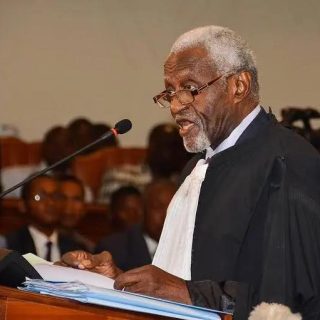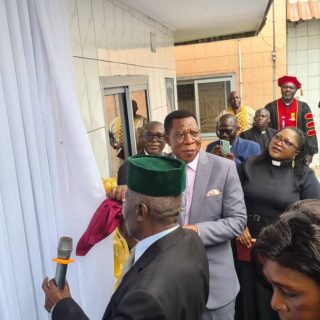Presidential Plan For The Reconstruction And Development of NW /SW Regions: Gov’t Borrows 21 Billion FCFA From Islamic Development For PPRD – NW/SW

Presidential Plan For The Reconstruction And Development of NW/SW Regions, PPRD – NW/SW:
Gov’t Borrows 21 Billion FCFA From Islamic Development For PPRD – NW/SW
Will this money go for the purpose for which it was borrowed?
Decree No. 2023 / 330 of 04 August, 2023 that was signed by President Bya, ratified a loan agreement of the sum of 32.250 million euros, which is about 21,115 billion FCFA (Twenty one billion, 115 million francs CFA), that was reached or concluded between the Republic of Cameron and ‘Banque Islamique de Developement’ (Islamic Development Bank). The loan on paper is destined for the Presidential Plan for the Reconstruction and Development of the Northwest and Southwest Regions, PPRD – NW/SW.
The loan is taken from the Islamic Development Bank, within a backdrop of questions on how the 11.6 billion FCFA (Eleven billion, six hundred million francs CFA) that was raised for the first phase of the PPRD – NW / SW, was managed.
Meanwhile, if THE MENTOR says the loan on paper is destined for the PPRD – NW/SW, it is because the Biya Government is noted for dishonesty, in that it a times would advance one reason to borrow money, then when the loan is granted it will quietly divert part or the entire funds elsewhere.
Sale Of Public Bonds In December 2018
In December 2018 for example, the Biya Government in the name of the State of Cameroon raised over 100 billion francs CFA through the sale of public bonds. According to a pamphlet was prepared by the Ministry of Finance, and which was further expatiated upon by the Minister of Finance, Louis Paul Mataze, at the official launching of the bond sales which took place at the GICAM Headquarters in Douala, a bulk of the funds was destined for sports infrastructures (stadia), as Cameroon then was preparing to host the African Cup of Nations, AFCON.
Meanwhile the other part of the funds was shared to a number of projects and State establishments in different parts of the country. As regards the two Anglophone Regions that were programmed to receive very little, one billion francs CFA was supposed to go to SOWEDA as State subvention, one billion francs CFA to PAMOL Plantations as State subvention, and two billion francs CFA to start the construction project for a second entrance into Bamenda from the direction of Bafoussam, to start from the Mile 8 (Akum area).
Project For the Second Entrance Into Bamenda
It should be noted that the importance of a second entrance into Bamenda from the direction of the West, Littoral and Centre Regions, cannot be overemphasized. Up till now there is only one main entrance into Bamneda from these regions, which is through Akum. But the topography of Akum, a hilly zone that often suffer from small landslides, is a serious cause for worry. If any unfortunate incident occurs at the Akum and cut off that road, then Bamenda is cut off. The only main road to enter Bamenda from the West, Centre or Littoral Region, will be to go through the Southwest Region (Kumba – Mamfe – Bamenda).
Meanwhile till date, the project for the construction of a second entrance into Bamenda from Mile 8 has not started, and there is no indication that it will start anytime soon. The question then is, what happened to the two billion francs CFA that the Government, raised through the sale of public bonds in December 2018, and said that it was being allocated for the start of the project for the construction of a second entrance into Bamenda? Your guess is as good as mine.
The 1 Billion FCFA That Was Meant For PAMOL Plantations
Meanwhile, the aforementioned one billion francs CFA that was supposed to go PAMOL Plantations in Ndian Division as State subvention was also diverted, to something else by Government. After that successful operation by Government to raise funds through the public bond sales in December 2019, stories rapidly circulated in PAMOL Plantations, that the Government had given one billion francs CFA to the State owned company that had been hard hit by the Anglophone Crisis. PAMOL camps were filled with unbridled joy, as workers that had gone for months without salary or wages, looked forward to receiving something, even though that was not the main purpose of the subvention.
The main purpose of the one billion francs CFA subvention was to help PAMOL that had almost crumbled, to revive its activities, especially the rehabilitation of its workshops and mills, where a lot of maintenance work was needed. Of course the workers also had to be given something. Suffice to say that when news went round that the Government had disbursed one billion Francs CFA to PAMOL, the management of the agro industrial company came under all sorts of pressure from hungry workers, who were expecting to receive at least part of their accrued unpaid salaries.
But then the management of PAMOL anxiously waited and waited, but the one billion francs CFA State subvention did not enter the company’s account as was expected. The then General Manager of PAMOL, Chief Charles Mekanya, travelled to the Ministry of Finance in Yaounde, to find out what had happened. But he was instead directed to go to the Public Treasury.
Money From Sale Of Public Bonds Don’t Enter The Public Treasury
But it should be noted that the funds which the Government raises through the sale of public bonds, are not kept or put in the Public Treasury. What happens in principle is that when there is any such operation, the Government opens a special account of the State of Cameroon, at the Central Bank, that is the Bank of Central African States, commonly known by the French acronym, BEAC. All the money raised through the operation, are paid into that special account by the consortium of commercial banks, that is the financial houses that the Government had engaged through an agreement, for the operation.
In principle, the Government at the appropriate moments or times withdraws the money from the special account, and channel directly for the payments of the different projects that were officially laid out by the Government, as the purposes for which the funds were raised. It is the same thing for the State subventions. The one billion francs CFA of State subvention for PAMOL Plantations, was supposed to leave from the special account at BEAC, and go straight into the account of the company. For the Ministry of Finance to have asked the General Manager of PAMOL Plantations, to instead go to the Public Treasury for the money, clearly meant that the one billion francs CFA in the special account at BEAC that was meant for PAMOL, had been withdrawn by Government and diverted to something else.
No Money In Public Treasury
Meanwhile, when the then General Manager of PAMOL Plantations, Chief Charles Mekanya, went to the Public Treasury in Yaaounde as was directed by the Ministry of Finance, he was told that there was no money, for the coffer of the treasury was empty. He had to return to the PAMOL Headquarters at Ekonod Titi, empty handed. The PAMOL Boss later travelled to Yaounde a number of times for the same purpose, but the story was still the same at the Public Treasury. That is, there was no money in the coffer of the Public Treasury.
One day a senior official (Francophone) at the Public Treasury in Yaounde, told the General Manager of PAMOL, Chief Charles Mekanya, to stop wasting his time travel to Yaounde every now and then, for money. The man frankly told him that since the Anglophone Crisis escalated to a war, any money that enters the coffer of the treasury immediately went to the military, which had been given top priority by Government. The General Manager returned to Ekondo Tit, shattered with the advice that he should stop wasting his time to travel to Yaounde every now and for the one billion francs CFA, for there was no money in the Public Treasury to give PAMOL.
Meanwhile the PAMOL Boss, Chief Charles Mekanya, found himself in a very difficult situation. There was the incessant pressure that was coming from hungry workers, who were demanding part of their accrued salaries or wages, Also, just as Chief Mekanya had feared, a rumour sparked off and was making its rounds in PAMOL Estates and camps that he had embezzled the one billion francs CFA that Government allegedly gave to PAMOL.
Ring Road Project – The 106 Billion FCFA From AfDB
There is also the case of the Bamenda Ring Road Project. The all -important 365 km National Road No. 11, starts from Bamenda, the Northwest Regional Headquarters, and runs through Bambui, Ndop, Babessi, Jakiri, Kumbo, Ndu, Nkambe, Misaje, Nyos , Wum, Bafut and back to Bamenda. Before Paul Biya became President of the Republic in 1982, the population of the then Northwest Province had been crying for the tarring of that road.
During an official visit to Bamenda in 1991, President Biya in his address promised that he would personally supervise the tarring of the road. But for 25 years or ¼ of a century, nothing happened. It was in the heart of the Anglophone in Crisis, 2019, that the Cameroon Government obtained a loan of 12 billion FCFA from the African Development Bank, AfDB, for technical studies (feasibility studies) of the Bamenda Ring Road Project.
Then on June 22, 2020, President Biya signed a text empowering the Minister of Economy, Planning and Regional Development, to sign on behalf of the State of Cameroon, a loan for the partial funding of the Bamenda Ring Road Project, that is National Road No. 11, with the African Development Bank, AfDB. The loan agreement was signed at a ceremony in Yaounde on Monday, June 21, 2021 by the Minister of Economy, Planning and Regional Development, Alamine Ousmane Mey, who signed on behalf of the State of Cameroon, and the Managing Director of AfDN for Central Africa, Serge N’Guessan, who signed on behalf of the financial institution.
Suffice to say the African Development Bank accepted to grant the State of Cameroon, a loan of 106 billion FCFA for the partial construction of the Bamenda Ring Road, whose total cost was put at 155 billion FCFA. This meant that the Cameroon Government still had to search for 49 billion FCFA to complete the total amount needed for the road project. But as could also be seen, the loan from AfDB, 106 billion FCFA, constituted the bulk of the funds required for the construction of the Bamenda Ring Road Project.
Complaint Of Insecurity
When the Cameroon Government that had failed to construct the Bamenda Ring Road for decades, finally decided to negotiate a loan for the project in the heart of the escalated Anglophone Crisis, many thought that just as the Government supposedly used the 12 billion FCFA loan in 2019 to do the feasibility studies, so also did the Government know how it would use the 106 billion FCFA loan signed on June 21, 2021, to carry out the construction of the Bamenda Ring Road in the heart of the Anglophone Crisis.
But then when the Prime Minister, Chief Dr Joseph Dion Ngute, visited Bamenda in early October 2021, he told the Northwest population, or was it the Northwest people, that the Government had found the money for the construction of the Ring Road Project. But he said that it was left for the people to tell the separatist fighters to drop their guns for peace to return, so that the Ring Road could be constructed.
What Was The Real Intention In Borrowing The Money?
Worth noting that it was just on August 17, 2023, that the Government through the Ministry of Public Works, awarded the first contract for a small portion of the Ring Road, that is the Ndu – Binka – Nkambe stretch, to ’Societe MAG SARL’ owned by hey Jones Yembe. What is not known is whether the African Development Bank has already disbursed the entire package of 106 billion FCFA to the Cameroon Government. If that has been done, then it is certain that the money has since been diverted elsewhere.
One cannot obtain a loan to build a house in the month of July, which is in the heart of the rainy season, and then turn around and complain that he cannot start the project then because of rain, as if he did not know the period of the year before borrowing the money. The question will be whether the man’s real intention in borrowing that money, was for the house project or for something else.




